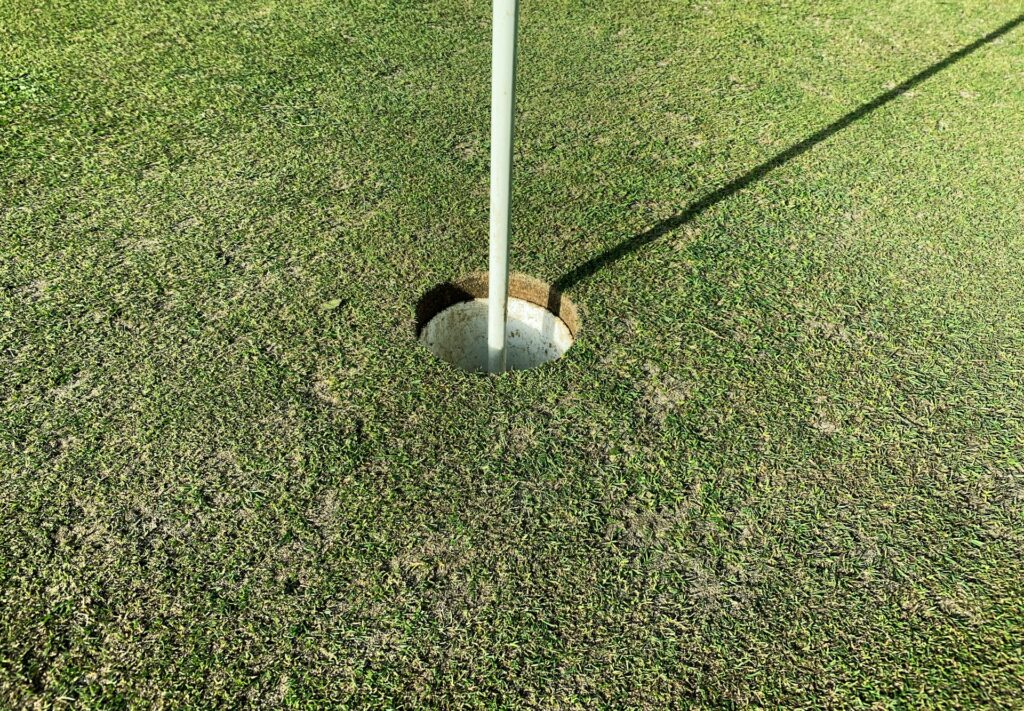
While it may seem like a simple concept, the size of the golf hole itself is a critically important aspect of the game at the professional level. The precisely defined 4.25 inch diameter has been the standard for over a century, acting as a central fact of the sport around which all gameplay, equipment, scoring, and stratification of skill is centered.
What are the Standard Dimensions of a Golf Hole?
The standard size of a golf hole is 4.25 inches (10.8 cm) in diameter and at least 4 inches (10.2 cm) deep. These dimensions are strictly regulated and enforced for professional golf tournaments. The hole size specifications ensure consistency and standardization across all golf courses used for professional play.
While the diameter measurement is fixed, there are no firm rules on the depth, only that it must be at least 4 inches deep. Many holes are dug deeper, around 6-8 inches, to allow for routine maintenance of replacing divots and resetting the hole liner. The hole liner is a circular plastic or aluminum casing that is hammered into the ground to reinforce the hole itself.
The 4.25 inch diameter allows the ball to easily drop in without being too wide that it compromises the challenge and skill required to sink a putt accurately. It’s a size that has been agreed upon for over a century of professional golf after some experimentation with different hole dimensions in the sport’s early years.
Golf hole size specifications extend beyond just diameter and depth measurements. The hole edge must be neatly cut with no ragged or folded over grass or turf ring around it. The hole circumference must have a smooth, cleanly cut rim for the ball to roll across when struck accurately on line. Maintaining this crisp, seamless edge is part of the daily grounds crew duties.

How Does the Hole Size Affect Gameplay?
The standardized 4.25 inch diameter of a golf hole has a significant impact on how the game is played at the highest levels. While it may seem like a small target, that precise size presents the ideal challenge for professional golfers to demonstrate their accuracy and touch on approach shots and putts.
If the hole was made larger, it would diminish the difficulty and make holing putts from distance almost trivial. The skills of lag putting, judging precise speed, and hitting a curling or breaking putt on the perfect line would be much less vital. A larger hole would reduce many of the subtleties involved in elite putting performances.
Conversely, if the hole was made smaller than 4.25 inches, it would make holing any putt outside a few feet exponentially more difficult. Such a small target would force players to essentially strike perfect putts just to have any reasonable chance of sinking it from 10-15 feet away. While this could showcase putting excellence, it would likely make for very high scores and frustrated professional players.
The 4.25 inch hole size strikes the right balance of being small enough to demand precision and touch while still allowing well-struck putts from the standard 30-40 foot circumference of the green to find the bottom of the cup. Holding the line over those stretches is one of the key skills that separates the best putters from the rest.

Why is the Hole Size Standardized in Professional Golf?
Standardizing the size of the golf hole at 4.25 inches in diameter is crucial for professional golf tours and major championships. Having a consistent hole size across all courses allows for an equal playing field and prevents any venue from being able to introduce an unfair advantage.
If hole sizes were to vary from course to course, it would drastically impact scoring and make it incredibly difficult to formulate tournament scorecards and maintain integrity in competition. A smaller hole could make a particular course play several strokes over par versus a regular 4.25 inch hole. Conversely, an enlarged hole would likely yield very low scores in relation to par.
By fixing the hole size, professional tours and governing bodies can set pedestrian par values (68-72) that apply universally regardless of the course setup. Slight variations in green speeds, rough height, etc. are still factors, but having a standard hole makes scoring much more predictable and comparable week-to-week.
Standardization also ensures historical significance to scoring records. If a player shoots 59 in an event, that jaw-dropping score can be immediately appreciated without caveats about non-regulation hole sizes. The game’s giants like Tiger Woods, Jack Nicklaus, etc. all pursued milestones like major victories under the same unified hole dimensions.
For professional golf’s purity of competition, as well as maintenance of reverence for its storied records and accomplishments, an unwavering official golf hole size is an absolute necessity. 4.25 inches has proven to be the perfect equilibrium for over a century.
Enjoyed this guide of how big is a golf hole? Then be sure to check out our other golf guides.
- Best Insoles for Golf Shoes
- Best Golf Cart Phone Holders
- Best Golf Tripods
- Best Knee Braces for Golf
- Best Golf Balls for Seniors
- Best Golf Cart Batteries
- Best Cooling Fans for Golf Cart
- Best Golf Cart Covers
- Best Golf Shoes for Plantar Fasciitis
- Best Coolers for Golf Cart
- Best Golf Balls for Beginners